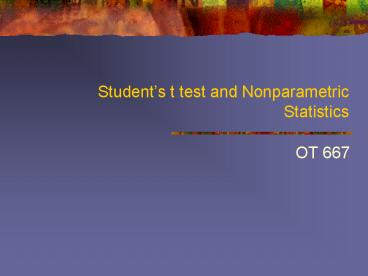Students t test and Nonparametric Statistics PowerPoint PPT Presentation
1 / 23
Title: Students t test and Nonparametric Statistics
1
Students t test and Nonparametric Statistics
- OT 667
2
Hypothesis testing defined
- A method for deciding if an observed effect or
result occurs by chance alone - OR
- if we can argue the results found actually
happened as a result of an intervention.
3
The Null Hypothesis
- In order to decide if the results of an
experiment occur by chance or if the effects seen
are the result of a treatment, researchers
declare a null hypothesis (Ho) and an alternative
or research hypothesis (Ha).
4
To test a hypothesis, researchers talk about
rejecting the null in order to demonstrate the
treatment has an effect.
5
When you reject the null, you say that there IS a
significant difference between the groups,
indicating the likelihood the treatment was
effective.
6
Decisions to reject or accept the null.
- Based on the alpha level or the probability that
a certain outcome will be achieved - By tradition, .05 is the most common alpha level
used to make this decision
7
Students t test
8
What is the t test?
- A parametric statistical test which analyzes the
difference between the means of scores between
two groups.
9
Calculating a t test
- The formula for independent t tests
- The difference between the means divided by the
variability within the groups
10
There are different formulas to calculate the t
statistic when variances within groups are equal
and when they are unequal
11
Assumptions
- There are assumptions about the data that need to
be considered when using the t-test. These are - the data is normally distributed
- the variances are homogenous or similar
- the groups are of equal size
12
The research question asked by the t test Is
there a difference between the two groups?
13
Two kinds of t tests
- t test for paired samples - when the subjects are
measured on a variable, receive the treatment,
then measured again. The pre and post-test means
of the measures are compared - t test for independent samples - comparison of
means between 2 different groups after a
treatment is administered
14
Example of an independent t test
- From the Case-Smith article, the difference
between pre and post test means on various tests
(DTVP, BOTMP) could have been compared between
the IG and the CG.
15
Example of a Paired t test
- In the Case-Smith article, paired t tests were
actually performed between pretest and postest
means for the IG only.
16
Multiple t tests
- When you read a study where several t tests are
used to test the same data, BEWARE - For example, a researcher writes an article on
the outcomes of a treatment used in persons with
dementia. More than one measure is used to study
the outcome. This means the risk of committing a
Type I error (rejecting a true null or finding a
difference when there isnt one) is increased.
17
Both point and interval estimates (confidence
intervals) can be calculated for t tests.
18
Solutions for the problem
- Perform an ANOVA
- Adjust the alpha level using a Bon Ferroni
correction - to do this you half or lower the
alpha level
19
Parametric Tests vs. Nonparametric Tests
- Parametric tests are based on assumptions made on
the normal curve normal distribution of data
and homogenous or similar variances - Nonparametric tests are used when the data is not
normally distributed or variances are dissimilar.
20
Criterion for Using Nonparametric Tests
- Assumptions of normality and homogeneity of
variance cannot be made - Data is ordinal or nominal
- Sample size is small (10 per group)
21
Comparable Parametric and Nonparametric Tests
- Mann-Whitney U test
- Wilcoxon Signed-Ranks Test
- Sign Test
- Kruskal-Wallis one way analysis of variance by
ranks - Friedman Two Way
- Independent samples t test
- Paired t tests
- One way ANOVA
- Factorial ANOVA
22
Hypothesis testing with nonparametric tests is
the same procedure as with parametric tests.
23
Test Power
- Parametric tests are seen as more powerful
- Are often used with inappropriate data because of
this - Need to assess the nature of the data carefully
to decide if the appropriate test is being used

